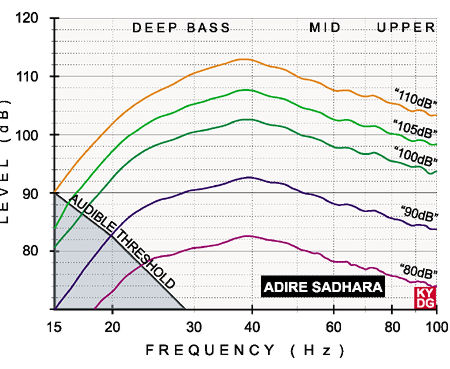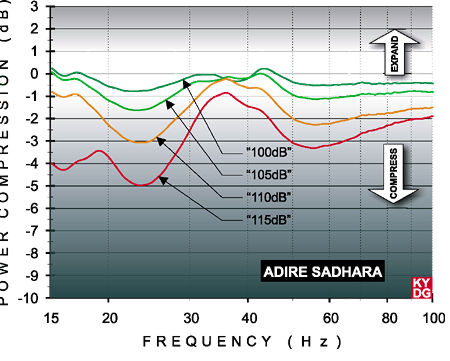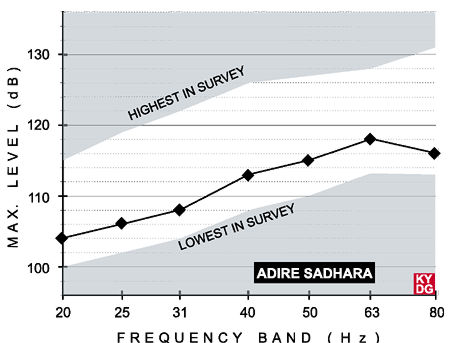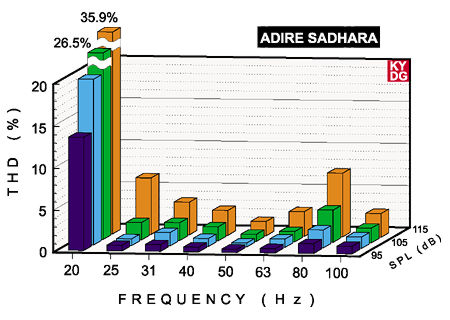Way Down Deep II Adire SaDhara
The Adire Sadhara was one of the subwoofers I evaluated in a test of mid-priced subwoofers I did for Home Theater magazine in 2003. Because it performed very well there—near the top, in some respects—it seemed appropriate to include it in this evaluation to provide a link to its more popularly priced siblings.
The Sadhara is the lowest-priced subwoofer in this installment's group of four. The logic behind its 18-inch-diameter, 39-inch-high cylindrical shape is not so much architectural as structural: As a driver moves in and out, compressing and rarefying the air in the chamber behind it, straight-sided enclosure walls will tend to bow in and bulge out to relieve the pressure, becoming, in effect, large-area, lo-fi drivers of their own. As a matter of basic physics, it's exceedingly tough to get the same sing-along effect from a cylinder because that would require it to expand and contract its diameter, a near-impossible proposition.
The Sadhara is a cylinder within a cylinder, each fashioned from a pouring form for concrete pillars, typically referred to by the trade name Sonotube. The 5/8-inch gap between the two is used as the port. The proprietary, 12-inch downfiring driver is said to offer a little more than 2 inches of peak-to-peak excursion, a feat the Lynwood, Washington– based firm touts as a benefit of its XBL2 motor technology (patent pending).
Measurements
Frequency response at 80dB (Fig.1): 20–100Hz, +/-5dB; 23–72Hz, +/-3dB; –10dB at 20Hz. Response was characterized by a broad hump centered at 40Hz.

Fig.1: Frequency Response vs. Output
Frequency response at higher levels (Fig.1): 115dB frequency-response measurements aborted due to subwoofer overload. 40Hz hump remained intact at all completed playback levels.
Dynamic range: The power compression at higher levels is shown in Fig.2. The curves there are normalized to the 90dB response; that is, the power-compression figures on the left (y axis) show only the changes in the response relative to the subwoofer's 90dB output. The maxi- mum output before audible distortion on Linkwitz shaped tone-burst tests (Fig.3) ranked in the lowest quartile among the 12 subwoofers in the survey.

Fig.2: Power Compression

Fig.3: Shaped Tone-burst Peak Output
Total harmonic distortion: From 25Hz and above, at levels up to 110dB, THD registered well below 5%, among the lowest in the survey (Fig.4). THD at 20Hz was high at all playback levels, suggesting that users exercise caution before electronically boosting the unit's response in the very deep bass. THD testing at the 115dB level was discontinued due to sounds of system distress.

Fig.4: Total Harmonic Distortion vs. Frequency & Level
Sensitivity: 91dB/2.83V/m at 40Hz, mea-sured outside.
Impedance: Nominally 4ohms throughout its 20–100Hz operating range, with minimum of 3.9ohms at 25Hz. The Sadhara should be partnered with a high-current power amplifier rated to deliver at least 200W into 4ohms loads.
Listening
Per my established routine (described in Part 1; see the June 2004 issue), I began each listening session by disconnecting the main speakers, feeding the test sub a string of bass torture tracks, turning the playback level up and down, and noting what I heard. As with the measurements, all the listening tests were conducted outdoors, and the quiet outdoor environs, insensitivity to placement, and complete lack of standing waves and other room effects made it much easier to dissect what the sub could and couldn't manage, and at what price in terms of distortion, compression, rattles, groans, squeaks, chuffs, and sundry other signs of distress
 On the lead-off track, "Jurassic Lunch," from Telarc's Great Fantasy Adventure CD (Figs. A1 and A2), the Sadhara managed to turn the ground-shaking dino clomp at 1:02 into a moderately deep-sounding thump that was free of noise accompaniment up to a maximum peak level of 100dB. It didn't reach deep enough or play loud enough to make it the obvious work of a T. rex, but it was clearly a clomp from a large animal—a cow or a horse, say, and not a musician scooting a chair on stage or other unintended noise that wasn't caught during mixdown.
On the lead-off track, "Jurassic Lunch," from Telarc's Great Fantasy Adventure CD (Figs. A1 and A2), the Sadhara managed to turn the ground-shaking dino clomp at 1:02 into a moderately deep-sounding thump that was free of noise accompaniment up to a maximum peak level of 100dB. It didn't reach deep enough or play loud enough to make it the obvious work of a T. rex, but it was clearly a clomp from a large animal—a cow or a horse, say, and not a musician scooting a chair on stage or other unintended noise that wasn't caught during mixdown.
Individual depth-charge detonations beginning at 1:19:35 in U-571 (Figs.B1 and B2) were crisp and free of any fuzziness or hashiness that might suggest that the 108dB peaks achieved were crowding the single 12-inch driver's mechanical and acoustical limits. But this track shows there's more to subwoofing than just getting it clean; there's also the matter of getting it all. On direct comparison with this track's standout performers—notably the Genelec tested in Part 1, the ServoDrive in this installment, and the Snell to follow in Part 3—the Adire couldn't tap the kind of sub-30Hz resources that can make the scene so shatteringly physical and harrowingly immediate.
The Sadhara turned in yeoman's performance in the Gooding-at-the-guns scene in Pearl Harbor (Figs. D1 and D2), where strong, sustained energy is spread throughout the 25–35Hz range. The Sadhara yielded to a few of its larger, box-type competitors only in A/B comparisons with this track, and then only south of around 30Hz. Absent a direct, level-matched comparison, the big cylinder mustered enough clean output in the 30–35Hz range to make the visual report—namely, of standing next to a man unleashing a desperate barrage of anti-aircraft fire—satisfyingly believable.
The Black Hawk Down selection (Figs.C1 and C2) fared a little less successfully. The inability to mount more than a half-hearted argument for the 18Hz rumble that underpins the Marines' scramble to the helicopters limited the Sadhara's capacity to instill that queasy sense of dread that makes the scene so riveting.
My test selection from The Matrix, beginning where the chopper blades strike the skyscraper at 1:51:03, came off convincingly despite the sub's inability to play the strong 14–20Hz eruption around 15 seconds in. The impact and explosion of the pod racer in the tunnel scene in Star Wars I: The Phantom Menace also came off with no markdowns in any category; everything was in its place, everything clicked.
With music, the final cannon blast in the Telarc 1812 Overture DVD-Audio (Erich Kunzel, Cincinnati Pops) took on a crackling sound, like someone clearing a throat or even gargling, at too low a level for the piece to work. But other, less taxing tracks came off quite nicely. "March of the Exorcists," from the Casper soundtrack CD, was an unqualified success, with well-shaped bass-drum strokes providing a just-right foundation; indeed, I felt "no need," according to my session notes, "for more, deeper, cleaner, or better-balanced bass." Likewise, it was hard to fault the big bass-drum whack in Holst's First Suite for Military Band, which topped 104dB without a trace of trouble. The bass line in "Flight of the Cosmic Hippo," from Béla Fleck's CD of that name, fared immaculately up to 99dB (subwoofer only, measured at 2m, main speakers disconnected), beyond which the onsets of plucked fretless bass notes became shrouded in fuzz and occasional crackles.
Specifications
Adire Sadhara non-magnetically shielded, port-loaded, passive subwoofer in cylindrical cabinet of 5/16"-thick, 16"-diameter Sonotube (processed wood fiber) nested within outer cabinet of 18"-diameter Sonotube
Driver: 12" cone of processed pulp & Kevlar with 2.25" peak–peak linear excursion
Frequency response: 17–500Hz, +0/–3dB in room
Inputs: gold-plated 5-way binding posts
Recommended amplification: 300–800W continuous
Finishes: black faux leather; wood, special finishes available at extra cost
Dimensions: 39" x 18" (Hxdiameter)
Weight: 90 lbs
Price: $999
Adire Audio
(425) 778-9663
www.adireaudio.com
- Log in or register to post comments































































